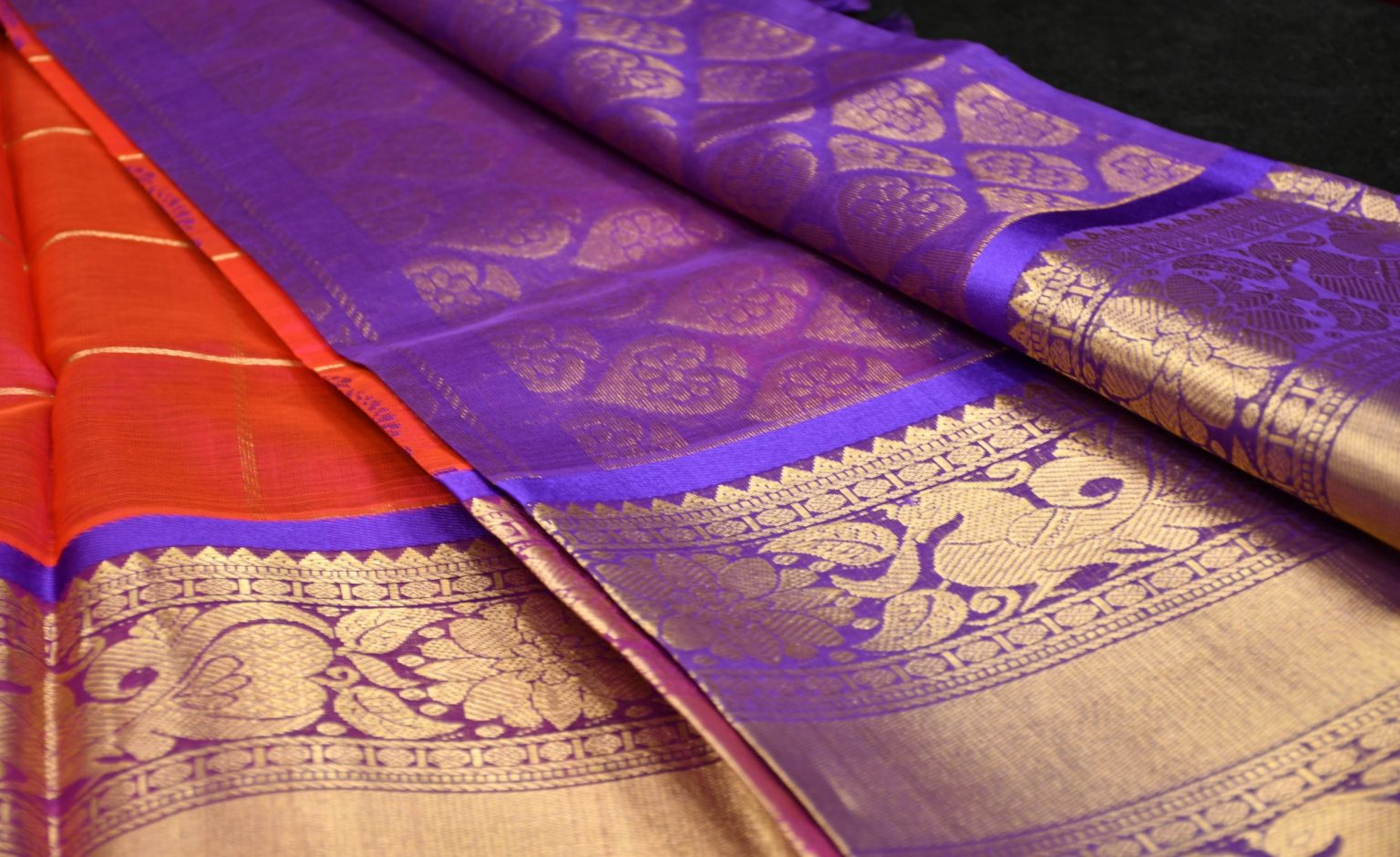The Nellore district of Andhra Pradesh is a tapestry woven with rich cultural heritage and exquisite textiles. Among its many treasures, the Paturu Cotton Silk Saree stands out for its unique blend of comfort and elegance. Hailing from the quaint village of Paturu in the Kovur Mandal, these sarees possess a distinctive charm that has captivated saree connoisseurs for generations. Paturu is not only celebrated for its handloom sarees but also holds historical significance as the birthplace of the great Telugu poet, Tikkanna Somayaji, who translated parts of the epic Mahabharata into Telugu [4]. This traditional craft has been recognized under the “One District One Product” (ODOP) initiative for the SPSR Nellore District in Andhra Pradesh [4].
The Paturu Cotton Silk Saree is a testament to the skilled craftsmanship of the local weavers. These sarees are predominantly woven with cotton for the body (warp) and silk for the border and pallu (weft), a combination that offers the best of both worlds: the comfort and breathability of cotton with a touch of luxurious sheen [4].
Historical Roots: The tradition dates back to the early 1900s when Paturu weavers produced cotton panche/dhovathi with a subtle half-inch silk border. These garments gained considerable popularity in the Chennai Film Industry and were even exported. Early “dhovathi/panche” were often woven with a 2-inch “kaddi” border and measured 8 yards in length. Some unique practices included the use of “Kaarikam Yarn” (yarn without boiling) for certain types of dhovathies and sarees [4]. The exceptional quality of Paturu cotton sarees was attributed to the “jonnapanne” used in the “mala maggam” loom [4].
The “Mala Maggam” Era: Around the 1940s, a distinctive loom known as the “Mala Maggam” was in use, famously employed by weaver Sri Byna Subbarayudu. This substantial loom required about 24 square yards of space. A truly unique and now discontinued feature of the “Paturu Sarees” was the “dyeing of yarn ‘on loom’,” a technique rarely found elsewhere in India, where the pallu was dyed by tying and draining it directly on the loom [4].
Evolution in the 1990s: The 1990s marked a significant shift as weavers began incorporating silk yarn for ½ inch selvedges (“jamullu”) in the borders. The “Muvva Netha” weaving technique was also introduced to achieve a finer finish. Subsequently, weavers integrated two lines of 1-inch silk yarn into the pallu. This evolution, particularly the combination of cotton with silk borders and pallus, caught the attention of film stars, who showcased Paturu sarees in their films, leading to widespread recognition [4]. Back then, sarees were woven using 120-count cotton and 3-ply silk, with the “jonnapanne” processing the yarn during weaving to ensure superior fabric quality [4].
Since then, the weavers in Paturu have refined this technique, naming the product the ‘Paturu Pattu Saree.’ They predominantly use 100 or 120-count cotton yarn for the warp and 3-ply silk yarn for the weft, often creating plain sarees with a “kaddi” border. In those days, weavers earned around Rs. 300 for five sarees. The use of pure mulberry silk (3-ply) and pure Surat silver and gold Zari, sometimes twisted with cotton thread, contributes to the rich, grand appearance of these sarees [4].
Distinctive Features and Specifications
Paturu Cotton Silk Sarees are renowned for several characteristic features that set them apart:
- Affordable Elegance: The strategic use of cotton in the warp and silk in the weft provides a luxurious look at a more accessible price point, making them comfortable and appealing to a broader audience [4].
- Raw Materials: The primary materials include 80s or 100s cotton yarn for the warp and 18/22 Denier Bangalore Silk yarn for the weft. Embellishments are often made with Pure Surat Silver & Gold Zari [4].
- Unique Border Designs: The silk borders and pallus are frequently adorned with traditional motifs, including floral patterns, creepers, and geometric designs, ranging from subtle to ornate.
- Lightweight Comfort: Despite the silk elements, the cotton body ensures the saree remains lightweight and comfortable for various occasions. A typical saree weighs between 300 to 450 grams [4].
- Vibrant Color Palette: Paturu Cotton Silk Sarees are available in a diverse range of vibrant and earthy colors.
Loom Particulars & Dimensions:
- Type of Loom: Pit Loom
- Reed: Metal Reed (Count: 78, Width: 76)
- EPI (Ends Per Inch): 73
- PPI (Picks Per Inch): 64
- Saree Width: 48 inches
- Saree Length: 6.30 meters (5.50 meters for the saree, 0.80 meters for the blouse piece) [4].
- Wages: Weavers typically earn Rs. 400 to Rs. 600 per saree, depending on the design [4].
Traditional Techniques Applied
The artistry of Paturu sarees involves several specific techniques:
- Street Sizing: This process involves applying a starch-based adhesive to the yarn before it’s wound onto pirns and woven. It enhances yarn strength and ensures uniform sizing [4].
- Piecing of Heald Shaft: Yarns from the cloth beam are carefully taken from the heald shafts and tied to the warp beam yarns using ash powder. This intricate step typically takes a full day and costs Rs. 600 to Rs. 800 [4].
- Charkha Winding: This involves the process of pirn winding and “dubba” winding, where silk yarn is meticulously wound onto pirns from the silk yarn dubba for use in weft picking on the loom [4].
Cultural Significance and Current Landscape
Paturu Cotton Silk Sarees are more than just garments; they are deeply ingrained in the cultural fabric of Nellore. They are a staple for festivals, weddings, and other special occasions, symbolizing tradition and grace. The handloom weaving sector is a vital part of the local economy, providing livelihoods for numerous families in Paturu and its surrounding areas [4].
Currently, the district boasts approximately 3800 handlooms, supporting around 9000 weavers. Notably, 3648 handlooms are dedicated to producing Paturu Cotton Silk Sarees, while others craft Venkatagiri, Kanchi, and Kuppadam sarees, among other products [4].
Preserving the Craft
In recent times, significant efforts are being made to preserve and promote the unique art of weaving Paturu Cotton Silk Sarees. Initiatives focused on supporting weavers, providing access to better resources, and creating robust market linkages are crucial for ensuring the sustainability and continued legacy of this traditional craft.
The Paturu Cotton Silk Saree is truly a legacy woven in threads of cotton and silk, reflecting the rich cultural heritage and unparalleled artistic skills of the Nellore region.
References:
- Andhra Pradesh State Handloom Weavers Cooperative Society Limited. [Invalid URL removed]
- District Census Handbook, Nellore. Directorate of Census Operations, Andhra Pradesh. (Note: Specific year and link may vary based on publication).
- Textiles Committee, Ministry of Textiles, Government of India. (Note: Specific reports and links may vary).
- Sri Potti Sriramulu Nellore District. Paturu Cotton Silk Sarees. https://spsnellore.ap.gov.in/paturu-cotton-silk-sarees/
Disclosure: This article has been written and edited with help from Google Gemini.

